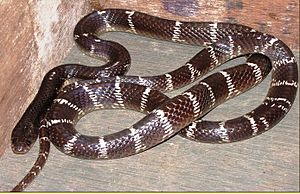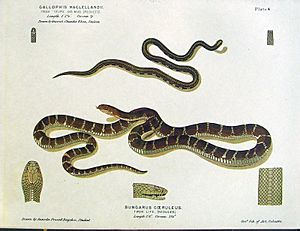Common Krait facts for kids
Quick facts for kids Common krait |
|
|---|---|
 |
|
| Scientific classification | |
| Kingdom: | |
| Phylum: | |
| Subphylum: | |
| Class: | |
| Order: | |
| Suborder: | |
| Family: | |
| Genus: | |
| Species: |
B. caeruleus
|
| Binomial name | |
| Bungarus caeruleus (Schneider, 1801)
|
|
| Synonyms | |
|
Pseudoboa caerulea Schneider, 1801 |
|
The common krait (Bungarus caeruleus), also known as the Indian krait or blue krait, is a type of venomous snake. You can find it in the jungles of the Indian subcontinent. It's one of the "big four" snakes in India. This means it's responsible for many snakebites there.
Contents
Discover the Common Krait
What Do Common Kraits Look Like?
Common kraits are usually about 0.9 m (3.0 ft) long. Some can grow much longer, up to 1.75 m (5 ft 9 in). Male kraits are longer and have longer tails than females.
Their heads are flat, and their necks are not very clear. Their bodies are round and get thinner towards the tail. The tail is short and has a rounded tip. Kraits have small eyes with round pupils.
Where Do Common Kraits Live?
You can find common kraits in many parts of India, from Sindh in Pakistan to the plains of West Bengal. They also live throughout South India and Sri Lanka. They can be found in places up to about 1600 meters high. They have also been seen in Afghanistan, Bangladesh, and Nepal.
These snakes live in many different places. They like fields and low scrub jungle. They also live near people. You might find them in termite mounds, piles of bricks, or even inside houses. They are often found near water.
What Do Common Kraits Eat?
Common kraits mostly eat other snakes. This includes "blind worms" (snakes from the Typhlops group). They also eat other kraits, even young ones. Besides snakes, they hunt small mammals like rats and mice. They also eat lizards and frogs.
How Do Common Kraits Behave?
Common kraits act differently during the day and at night. During the day, they are slow and usually calm. They often hide in holes made by rodents, loose soil, or under trash. Because of this, you rarely see them during the day.
They often roll their bodies into a loose ball, hiding their head inside. When they are in this "balled" shape, you can handle them a bit. But if you handle them too much, they might bite.
At night, these snakes become very active. If they feel bothered, they might hiss loudly or stay still. Sometimes, they will bite if annoyed. If a krait feels threatened, it will coil up with its head hidden. Its body will flatten, and it might make quick, jerky movements. It might also lift its tail.
Kraits usually don't want to bite. But if they do, they often hold on for a while. This allows them to inject a good amount of venom. They can become aggressive at night if they feel threatened.
Understanding Krait Venom
The common krait's venom is mostly made of strong neurotoxins. These toxins affect the nervous system and can cause muscles to become paralyzed. Krait venom affects the nerve endings in the brain.
Kraits are nocturnal, meaning they are active at night. So, they rarely meet humans during the day. Most bites happen at night. Often, a krait bite causes little or no pain at first. This can make a person think the bite is not serious.
However, victims usually start to feel severe stomach cramps. Then, their body slowly becomes paralyzed. If someone is bitten, it's important to get help right away. Applying a pressure bandage to the bite area can slow down the venom. The bandage should be about as tight as one for a sprained ankle. It's also important to keep the bitten area still.
Images for kids
See also
 In Spanish: Krait común para niños
In Spanish: Krait común para niños





